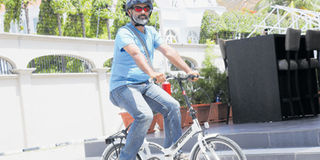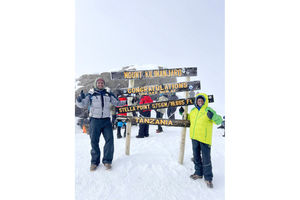Kermalli: That healthy life is just a bicycle ride away

Sameer Kermalli has cycled a total of 110 kilometers since he began adopting cycling as his way of life. PHOTO|ANTHONY SIAME
What you need to know:
This, however, isn’t the case for a 43-year-old resident of Dar es Salaam, Sameer Kermalli who cycles 90 per cent of all his daily activity routes within and outside the city of Dar es Salaam.
Most people believe the best way to exercise for the body is through jogging, running, and skipping rope, though, in recent years, the growing trend of people’s preference for exercising has been a gym workout.
This, however, isn’t the case for a 43-year-old resident of Dar es Salaam, Sameer Kermalli who cycles 90 per cent of all his daily activity routes within and outside the city of Dar es Salaam.
Kermalli has cycled a total of 110 kilometres since he started in 2007. His friend’s willpower and determination played a big role in motivating Kermalli, who cycled 350 kilometres from Dar es Salaam to Kilwa for 12 hours.
The beginnings
Cycling has always been part of Kermalli’s life since the age of 11, “My dad bought me my first BMX-brand bicycle, which I used when going to shops, markets and the like.”
He says the bicycle was later stolen and had to adjust to living without one until he decided to buy another one after he completed his higher studies in 2007. “My decision to buy a bicycle was inspired by the book, ‘The Monk Who Sold His Ferrari’ by Robin Sharma, I wanted that freedom to go to places and have adventures,” says Kermalli.
The book is about a high-profile attorney Julian Mantle, who was making good money, possessed a Ferrari, travelled all over, had a family and all in all one could say, he had everything. In the contrary, nothing was going right for him from within, neither his health was stable nor his marriage.
At the age of 45, the protagonist of the book got a heart attack and realised he couldn’t endure the stress anymore, so he decided to leave everything behind (including his Ferrari) and went to Himalayas to start a new life. There he met a monk, from where his life seemed to have been recycled once again.
For two years, Kermalli worked at Precision Air Company as a Publication Manager where he wrote motivational articles on different issues before he decided to freelance in photography and design.
“I wasn’t cycling to work during that time but used to cycle to SeaCliff from Upanga where he resides) after work and on Sunday mornings.”
As he started freelancing, he cycled often to clients and that became a routine, his lifestyle. Kermalli later came across a group of cyclists dubbed Dar es Salaam Active Cyclists (DAC) and decided to join them due to their dynamic nature. The group conducts routes to cycle in the evening throughout the week and on weekends as an exercise routine. The routes vary from across the city centre, Kigamboni to Bagamoyo.
Kermalli explains that the group challenges and helps members to develop the spirit of cycling to longer routes than those they usually ply.
The DAC’s founder Mathias David, 26, said that the primary idea was to cycle around town, just to simplify his movements but realised sooner that it could be a lifestyle that’s crucial to body health.
“I started cycling alone and after a while I was joined by my friend, Nikas Msale, who cycled with his family on Sundays. I then began advertising the weekend cycling on social media and witnessed different people joining in, it kept growing and has now become a team of active cylists,” David explained in an interview with Your Health.
David added that when he first started advocating, his focus was to enhance health fitness to the public through cycling.
Cycling combats serious health issues
Kermalli echoed David sentiments about the issue of today’s youth who ignore body building-exercising lifestyle, later on become victims of non-communicable diseases. These diseases are preventable through lifestyle changes such as adopting cycling.
The World Diabetes Foundation last year’s global studies showed that Non-Communicable Diseases (NCDs) which are mainly diabetes, cardiovascular diseases, chronic respiratory diseases and cancers attribute to 60 per cent of all deaths.
A recent survey on the ‘strategic and action plan for the prevention and control of communicable diseases in Tanzania 2016/20,’ shows that the burden of diabetes and cardiovascular diseases to NCD is high with the prevalence of hypertension estimated to be around 26 per cent.
“I cycle for health and I am healthy. When you cycle, your whole body is at work from your mind, hands and legs, back, waist and every part of the body,” says Kermalli.
He reveals that he hasn’t had malaria since 2013, knows no antibiotics for years now and has completely forgotten what common cold is like; his life has been disease-free since cycling became part of his lifestyle change.
“I frequently donate blood because my hemoglobin is over 30, which indicate my blood regeneration is strong because of my good health,” Kermalli attributes to the practice of cycling.
According to the Exercise and Endocrine Physiologist of the Muhimbili University of Health and Allied Sciences (MUHAS), Dr Fredrick Mashili, cycling stands for three body exercises, which are aerobic (cardiac), resistance (muscles) and flexibility (organs).
Dr Mashili explained to Your Health that cycling has advantages in both physical and mental aspects of body. It regulates heartbeats, muscles and organs like lungs, pelvic as well as regulates hormones into healthy levels.
Mentally, cycling helps to produce endorphins, which are brain chemicals that stimulate feeling of happiness and easiness, reduces forgetfulness and increases alertness and all these highly boost up performance in other activities.
He also added that medical studies show that people who cycle look and feel 10 years younger than those who don’t.
Before one opts for cycling as their exercise routine, Dr Mashili advices in doing a checkup to know his/her health condition. This will enable one to know their self-body type and metabolism, so that the extent one exercises wouldn’t be harmful to their health.
Kermalli brings up the issue of obesity and how cycling can help to solve it. He gives an example of his friend called Cyrus Dupetawalla, 47, a Sales and Marketing Manager at Computer Sales and Services (CSS) who weighed 140kg and so started cycling in March last year, to reduce his weight. Today he weighs 90kg.
Obesity and overweight in Tanzania is also an alarming health problem. According to the ‘2016 Global Nutrition Report’, nearly 10 million Tanzanians are overweight with a large proportion among them being obese.
The report states that over 26 per cent of the Tanzania’s adult population are overweight, and 7 per cent others obese, thus putting them at higher risk for non-communicable diseases.
The road to a disciplined life
Cycling has disciplined Kermalli on eating behaviour but also assured him of high burning of calories such that he can take in fats without fear of putting on too much weight.
The cyclist has a car. He admits to barely driving it to places. “I fill full tank in my car that endures the whole month, however, I have saved a decent amount of money that could otherwise be consumed on fuel,” he says.
Kermalli tells that cycling has saved him a great deal of time that he could have wasted on traffic jams if he used his car, and uses the time saved for other socio-economic activities.
Just like the famous tale goes ‘walk with a thief, so will you be’, Kermalli’s wife Mehjabeen Alarakhia is also a cyclist who started just as they married in 2009 after her husband bought her a bicycle.
Ms Alarakhia who works with UN Women as the Head of Women’s Economic Empowerment Section is a member of a women cyclist group that brings together women of different professions in Dar es Salaam to also cycle for health. She cycles 30 kilometers a week.
“After my husband bought me a bicycle, he used to ride with me when I was slow and learning to adjust to the terrain. Sameer has helped me understand the importance of using it for my health and most importantly to abide with safety rules when I ride,” she explains to Your Health.
Safety first
Speaking of safety, Kermalli’s mom once threatened to burst his bicycle tyres if he rode without helmet, the time he had bought his first bicycle.
“My mom stood with a knife telling me in a serious tone ‘if you don’t want the tyres busted, go buy a helmet before you start riding this thing, ’ and I had to go purchase one.
Just a few days later, I had an accident, got a minor concussion but went unconscious for four consecutive hours. Had I not worn the helmet my mom forced me to buy, I would have had a serious head injury,” Kermalli emphasises on wearing a helmet for safety.
He says it’s very crucial for all cyclists to first consider their safety when riding considering that road structures in Tanzania and drivers don’t pay attention to the rights of cyclists in using the roads.
“It is actually the biggest challenge we cyclists face because we’re considered road invaders and so often cyclists get hit by cars by careless or ignorant drivers by violating road rules,” Kermalli adds.
He highlights safety components when cycling starting with helmet that prevents head injuries in case of accidents and bicycle lights which can be reflectors or blinkers when cycling at night to ease visibility for other road users.




